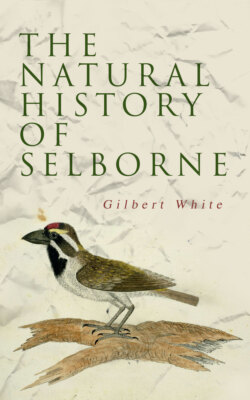Читать книгу The Natural History of Selborne - Gilbert White - Страница 9
На сайте Литреса книга снята с продажи.
LETTER IV.
ОглавлениеTable of Contents
As in a former letter the freestone of this place has been only mentioned incidentally, I shall here become more particular.
This stone is in great request for hearth-stones, and the beds of ovens; and in lining of lime-kilns it turns to good account, for the workmen use sandy loam instead of mortar, the sand of which fluxes, and runs by the intense heat, and so cases over the whole face of the kiln with a strong vitrified coat-like glass, that it is well preserved from injuries of weather, and endures thirty or forty years. When chiseled smooth, it makes elegant fronts for houses, equal in colour and grain to Bath stone; and superior in one respect, that, when seasoned, it does not scale. Decent chimney-pieces are worked from it of much closer and finer grain than Portland, and rooms are floored with it, but it proves rather too soft for this purpose. It is a freestone cutting in all directions, yet has something of a grain parallel with the horizon, and therefore should not be surbedded, but laid in the same position that it grows in the quarry. On the ground abroad this firestone will not succeed for pavements, because, probably some degrees of saltness prevailing within it, the rain tears the slabs to pieces. Though this stone is too hard to be acted on by vinegar, yet both the white part, and even the blue rag, ferments strongly in mineral acids. Though the white stone will not bear wet, yet in every quarry at intervals there are thin strata of blue rag, which resist rain and frost, and are excellent for pitching of stables, paths, and courts, and for building of dry walls against banks, a valuable species of fencing much in use in this village, and for mending of roads. This rag is rugged and stubborn, and will not hew to a smooth face, but is very durable; yet, as these strata are shallow and lie deep, large quantities cannot be procured but at considerable expense. Among the blue rags turn up some blocks tinged with a stain of yellow or rust colour, which seem to be nearly as lasting as the blue; and every now and then balls of a friable substance, like rust of iron, called rust balls.
In Wolmer Forest I see but one sort of stone, called by the workmen sand, or forest-stone. This is generally of the colour of rusty iron, and might probably be worked as iron ore, is very hard and heavy, and of a firm, compact texture, and composed of a small roundish crystalline grit, cemented together by a brown, terrene, ferruginous matter; will not cut without difficulty, nor easily strike fire with steel. Being often found in broad flat pieces, it makes good pavement for paths about houses, never becoming slippery in frost or rain, is excellent for dry walls, and is sometimes used in buildings. In many parts of that waste it lies scattered on the surface of the ground, but is dug on Weaver’s Down, a vast hill on the eastern verge of that forest, where the pits are shallow and the stratum thin. This stone is imperishable.
From a notion of rendering their work the more elegant, and giving it a finish, masons chip this stone into small fragments about the size of the head of a large nail, and then stick the pieces into the wet mortar along the joints of their freestone walls. This embellishment carries an odd appearance, and has occasioned strangers sometimes to ask us pleasantly, “whether we fastened our walls together with tenpenny nails.”
